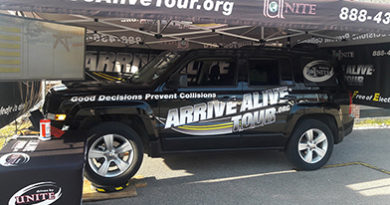National Driving Safety Tour Visits UTPA
 Pharr native Ines Varela was texting and driving on campus March 3 when she crashed, with no injuries resulting. She was only driving a simulator, and was able to see the effects that distracted driving can have in a life-like scenario.
Pharr native Ines Varela was texting and driving on campus March 3 when she crashed, with no injuries resulting. She was only driving a simulator, and was able to see the effects that distracted driving can have in a life-like scenario.
The simulation setup is part of the national Arrive Alive Tour, promoted by the health and wellness organization Unite International. The three-month tour has been visiting high schools and colleges for about two weeks. Students are allowed to experience the risk of texting and driving, or drunk driving, without being in a dangerous situation. Other Texas schools the tour has visited include Abilene Christian University and Houston St. Thomas University.
Unite is an organization that advocates all around wellness by visiting schools from elementary to colleges and holding events that include drivers’ education and bully prevention.
Between the Wellness and Recreational Center and Student Health Services, members of Arrive Alive set up their test-drive station. The vehicle was placed on platform disks that allow the wheels to move, while still keeping the car at a standstill. Sensors were connected to the steering wheel, gas pedal and brake. The sensors were also connected to a computer in the backseat so when the driver turned the wheel, the on-screen simulation was turning as well as the actual tires.
“You just put in: ‘They’ve had this many drinks in this amount of time, male or female’ and the computer kind of takes it from there. It calculates their blood alcohol content and then it’ll simulate it accordingly,” said simulation facilitator Jake Azman, a Michigan native working on the tour.
Blood Alcohol Content refers to the amount of alcohol contained in a person’s blood and is usually expressed in percentage. In Texas, the level of legal intoxication is .08 percent, but how soon a person gets intoxicated can vary depending on age, gender and weight
During the simulation, the driver puts on glasses that show a complete 180-degree city scene to travel through. If they are trying to text and drive, they wear the glasses while messaging. If they are imitating a drunk driver, the computer gives the glasses tunnel vision, blurry vision and delayed reactions.
A usual tour set up will have a tv screen displayed outside the vehicle so passers-by can see the driver’s point of view in the simulator.
”Our main purpose is advocacy against people getting behind the wheel when they’ve had too much to drink, and for keeping their cell phones in pockets when they’re driving,” said Azman, a 21-year-old Grand Rapids Community College student. “It’s going to be effective to show what’s it’s like.”
In 2011 McAllen city leaders banned sending and reading texts and browsing the Internet while driving. Prior to that, Texas banned drivers from using phones in school zones, and intermediate license drivers from cellphone usage altogether, including hands-free devices such as headsets.
According to the Texas Department of Transportation, there were 453 statewide fatalities in 2012 due to distracted driving.This includes driver inattention or cell-phone use.
“I think our generation is just so used to having everything at their fingertips now. They do it so often that they don’t even think, ‘I’m driving I should put my phone away,’” Azman said. “Our generation, we always have our phone on us. We don’t think about putting it down even when we’re in the car.”
The simulation facilitator explained that members of the tour go to about four schools a week. The drill takes on more urgency before Spring Break and high schools’ prom season because alcohol is often involved on those occasions.
When it comes to drunk driving, there were 376 DUI fatalities in Texas involving drivers between ages 21-30 in 2012 and 88 deaths under age 21, according to TxDOT.
The simulation volunteer Varela explained that she never drives under the influence because her brother died in a drunk driving accident when she was a senior in high school. However, the rehabilitation major admitted to sometimes fumbling with her phone while on the road.
The 23-year-old Varela explained that she’s never been in an accident while texting, but crashing in the simulator was a wakeup call and she is going to try keeping the phone in her pocket from now on.
“As far as texting and driving, I think that I do it because it’s just a habit,” she said. “You get the text, and maybe there’s a red light and think, ‘I can check it really quick,’ and you think it’s somewhat important, but it’s not that important. It can wait.”




You must log in to post a comment.